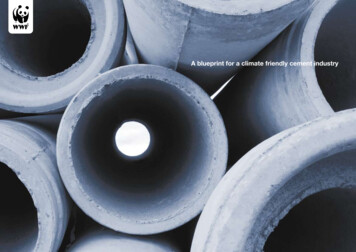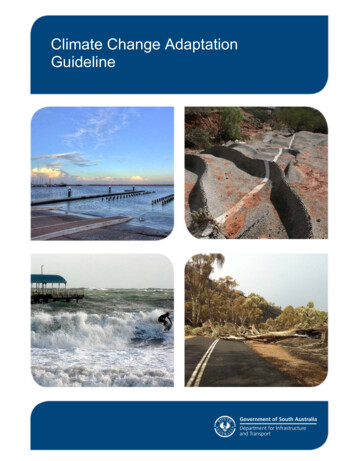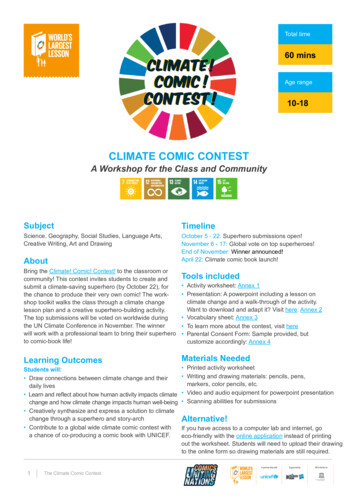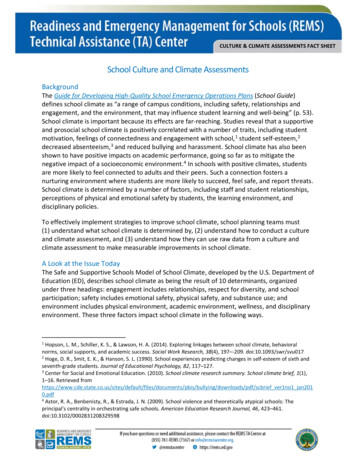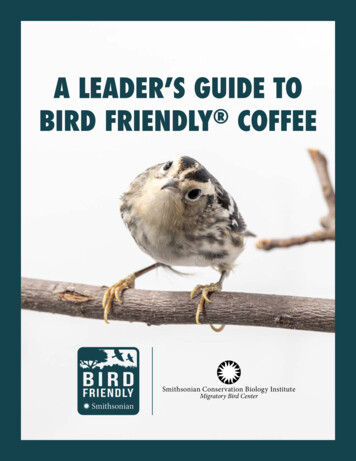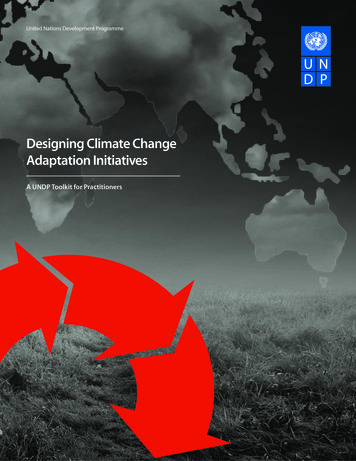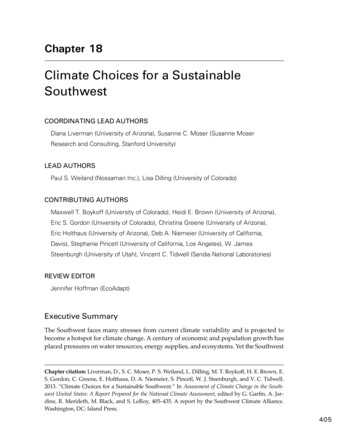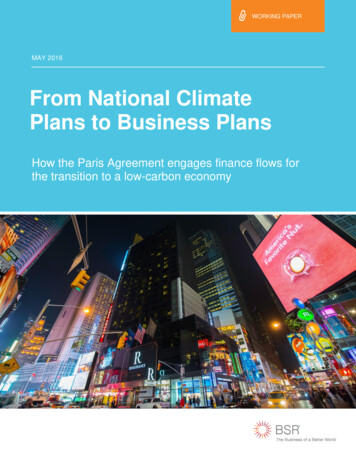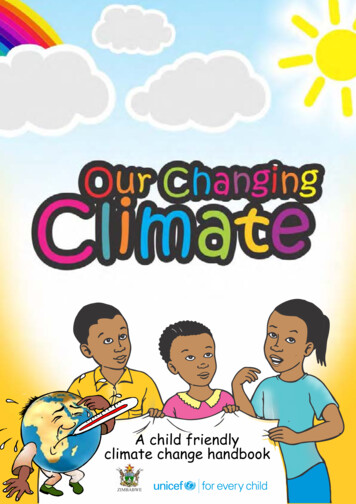
Transcription
A child friendlyclimate change handbookZIMBABWE
May 2017Published by UNICEF6 Fairbridge Avenue, BelgraviaP.O. Box 1250, HarareZimbabweThe information in this book can be reproduced with due acknowledgement.This booklet can be downloaded fromhtttp:/www.unicef.org/ZimbabweUNICEF Zimbabwe@UNICEF ZimbabweISBN: 978-92-806-4902-4AcknowledgementsOur gratitude goes to Jacquline Magwenzi andJoel Chikware (illustrations, design & layout) for putting together the material.(i)
A bout This BookThis book is a learning guide on climate change and how it is affectingeveryone. It is our hope that after reading it, users will have learnt thefollowing:1. What is climate change?2. How is it affecting us?3. How best can we deal with it?Cartoons and inforgraphics have been used in the book as a way ofcapturing the imagination and interest of children(ii)
ForewordThis book is a child friendly handbook meant to explain the concepts of climatechange in an easily understandable manner and language. It aims to linkbehavioural choices to the changes observed in our climate.The Children and Climate Change in Zimbabwe study of 2013 highlighted thegap in learning on the subject of climate change. Many children who participatedin the study could identify changes in their climate but lacked the knowledge onwhat to do about it. Thus they were powerless to change their circumstances.The country also underwent a curriculum review process during the same periodwhere the Primary and Secondary School curriculum was changed for the firsttime since independence. The new curriculum is more holistic and thus climatechange and the environment take prominence as they affect the well being ofchildren in many ways. This therefore presented opportunity to developresources for children on various topics previously limited in the curriculumincluding climate change.The Climate Change Handbook is about building a culture of environmentalstewardship from an early age. In this way it is aligned to the new curriculumwhich focuses on developing Learner Exit Profiles by developing different skillsets and attitudes through learning. As UNICEF we hope children will be able touse this handbook to help them learn more about climate change. We hope theywill also be encouraged to share the information and take action together withtheir communities to keep our environment clean, safe and healthy.Our Changing Climate: A Child-Friendly Climate Change Handbook wasdeveloped with the participation of children through pretest exercises. It wasdeveloped to be fun and engaging yet highly informative. This book has beenapproved by the Ministry of Primary and Secondary Education as additionalteaching and learning resource, under the subject environmental studies. Wetherefore take this opportunity to thank all the children, adults and the technicalteam including colleagues from the Curriculum Development TechnicalServices, a unit which helped in developing this handbook.This Child Friendly Climate Change Handbook book is appropriate for use byGrade 6 to 7 learners.Mohamed Ag AyoyaCountry RepresentativeUNICEF Zimbabwe(iii)
CONTENTSAcknowledgementsiAbout this BookiiForewordiiiContentsivGreetings1Chapter 1: The Earth and its climate3Chapter 2: Past and Present Climate9Chapter 3: Global Warming16Chapter 4: Climate Change32Chapter 5: Why Learn About Climate Change?64Activities67Key Terms72(iv)
GreetingsHello everyone! My nameis Chido and these aremy friends Sam and Thulani.We are climate changeactivists in our community.That’s right! An activist isa person who campaigns forsome sort of social changeactivists in our communityThank you for joining us in this book.I hope we will learn more about climatechange and how it is affecting us.1
Hello! I am ThulaniIt is true that climate change isbadly affecting us now and thereis need for us to do somethingabout it?Hello! My name is Sam. Inorder for us to know moreabout climate changelet s start by looking atthe earth and its climate.2
Welcome to Chapter 1The Earth and its ClimateIn this Chapter you will learn more about the following topics:1.2.3.The atmosphere and how it relates to the earthThe atmosphere and what it is made up ofThe difference between the weather and climateAt the end there will be a short activity to help you remember what youhave learned.SkillsThe intended skills to be developed in Chapter 1 include the following:1.2.3.Content MasteryRecognition of national symbolsCritical thinking3
ZIMBABWE4
The atmosphere is the air thatsurrounds us. It covers hundredsof kilometres. The atmosphere hasmany natural and man-made gasesin it. There is also a layer of gasescalled the Ozone layer whichsurrounds the earth. The Ozonelayer is important. It helps tomaintain life on earth.Ozone Layer5
time and place.6
ClimateClimate is the average weather condition in a specific time andplace. It is usually measured over a 30 year period. Seasonssuch as summer, autumn, winter and spring are used to describeclimate.Overall climate in ZimbabweSummerAutumnWinterZimbabweSpringFor example, Zimbabwe is generally sunny with a warm wetsummer and a cold dry winter.I hope you can see the differencebetween weather and climate.Weather is the state of theatmosphere over a short period oftime. Climate is the average weatherover 30 years. Let us now look at a fewthings that tell us more about past andpresent climates.7
Activity PageThe Earth and its Climate – The true picture!Answer True or False1.Climate and weather are the same thing.True/False2.Zimbabwe's climate is generally cool throughout the year.True/False3.The air we breathe is part of the atmosphere.True/False4.The climate is the long term state of the atmosphere.True/False5.Wind, rain and temperature are elements of weather.True/False6.The Earth is the only planet known to have life.True/False8
Welcome to Chapter 2Past and Present ClimateIn this Chapter you will:1.2.Learn more about how rain and temperature, water supply, foodsupply, trees and vegetation cover can be used to show a changingclimate.Be able to compare the past and present climatesAt the end of this Chapter you will have a chance to develop your investigativeskills and draw conclusions in a short activity.SkillsThe intended skills to be developed in Chapter 2 include the following:1.2.3.Critical thinkingProblem solvingNational Identity9
Past & Present Climate1. Rain & TemperaturePast rainy seasons1. The main rainy season began inOctober and ended in December.2. Post rainy season began fromFebruary and ended in April.3. Winter showers began in Mayand ended in July.Present rainy seasons1. Unreliable rainfall patterns.2. Little rain in a short period of time whichsometimes come once in a year.3. Very harsh rains accompanied bythunderstorms and oods.Past temperatures1. Hot summers2. Cold winters3. Predictable temperatures.We could tell before hand whatthe temperature would be at acertain time in the year10Present temperatures1. Extreme temperatures2. Heat waves now common3. Hot days and very cold winternights
2. Water SupplyIn the past, rainfall wasenough to meet the needsof people and animals.Rivers flowed throughoutthe year.Nowadays water fordomestic and commercialuse is a serious problem.Domestic (for the home)Commercial (for business)Livestock and wildlifeare also affected.2015 was one of the worst drought yearsin Zimbabwe. A large number of cattle,domestic animals and wildlife died dueto shortage of water.11
4. Trees and Vegetation CoverPast Vegetation1. In the past there were largeforests with big and healthytrees.2.There were fewer veld fires.PresentVegetationPresentVegetation1. There are more veld firestaking place in the country.2. There are more areaswithout vegetation covernowadays.By looking at the past and present conditions, wecan see that there are changes in our climate.These changes are affecting our environment.What are some of the changes taking placewhere you live?13
12
Activity PagePast and Present Climate – Back in time!It is easier to see changes over many years. The older the people are in ourcommunity, the more they have seen and experienced. This is true even for climatechange. For this activity identify at least 3 relatives from 3 generations(a generation represents all the people born and living at about the same time).In this case we will look at these generations:a. Your grandparents age groupb. Your parents age groupc. Your age groupAsk all three of them the following questions and write the answers down.Questions for the three relatives1. Temperaturea. What were the temperature conditions in winter when you were myage?b. What were the temperature conditions in summer when you were myage?2. Rainfalla. In which month did it start to rain and in which month did the rainsend.b. Did you have floods? If yes how often?c. Did you have droughts? If yes how often?d. Was the rain more or less than it is now?3. Vegetation and animalsa. Which wild fruits and plants did you eat and are they still found?b. Which insects and animals did they hunt and can you still find themnow?4. Harvestsa. Which crops did you grow and eat when you were my age?b. Were the harvests more or less than they are now?You can use the table overleaf to input your answers.14
Climate change trendsGrandparentParentMy ageWinterTemperatureSummerTemperatureRainfall startRainfall endFloods: How often?Droughts: How often?Wild fruits andplants that you ate?Animals and insectsthat you ate?Crops that you grewand ate?Were harvestsmore or less thanthey are now?Compare the answers from the 3 people interviewed and answerthe following questions.1. Has climate changed from the time your grandparents were young children?2. How reliable do you think this information is?15
Welcome to Chapter 3Global WarmingIn this Chapter you will learn more about:1.2.3.What global warming is and its causesGreenhouse gases and the greenhouse effect.The role of human activities in Global warming.At the end you will have a couple of activities to jog your memory and testyour comprehension of the topics covered.SkillsThe intended skills to be developed in Chapter 3 include the following:1.2.16Content MasteryCritical thinking skills
So what is causing thesechanges to our climate?Global WarmingScientists have discovered that changes to our climate arebeing caused by what is known as Global Warming which hasalways been there.Global warming is the average increase in the arth stemperatures.There are 2 kinds of Global Warming.1. Global warming from natural causes2. Global warming from human activities17
Global warming from natural causesVolcanic eruptions and natural fires are naturalevents which have always happened.They helped to keep the Earth warm.Global warming from human activitiesHuman activities are the main cause of the increase in globalwarming. The industrial revolution which began in the 18thcentury resulted in the use of a lot of fossil fuels. Use of fossilfuels released a lot of gases into the atmosphere. As a resultthis has led to the Earth getting warmer.Human Activities18Fossil fuels are fuels that form when organicmaterial (the remains of once-living things) isburied under great pressure and temperatureover millions of years. They take ages to formbut only a little time to burn.
But how does adding gases into theatmosphere result in global warming?For us to understand global warming, we need to understand thegreenhouse effect and what Greenhouse gases are.Greenhouse GasesGreenhouse gases are found in the ozone layer. They are sometimesknown as heat trapping gases. Examples of greenhouse gasesare, water vapour, carbon dioxide, methane, nitrous oxide andflourinated gases.SunHeat fromthesunSomis t e of tgre rappe he headenhous by th teegasesHeat comes backagain to earthafter failing togo through thegreenhousegasesPlanet EarthGreenhouse gases are natural or manmade gases in theatmosphere. They act like a protective blanket around the Earth.They trap heat to keep the Earth warm and this process isknown as the greenhouse effect.Water Vapour is the most abundantgreenhouse gas in the atmosphere.19
The Greenhouse EffectThe greenhouses used by farmers help us to explainthe greenhouse effect. Have you ever seen a greenhouse? In some areas farmers build a plastic houseto plant crops in. It is built so as to allow the sun'srays to enter. The purpose is to prevent the heatinside from going back into the atmosphere.In a way the Earth is likethis plastic house. Theplastic on the greenhousetraps heat causing thetemperature inside thegreenhouse to increase.In the same way thegreenhouse gases trapheat in the Earth'satmosphere causing theearth's temperature toincrease. This increase intemperature is calledGlobal warming.Since these gases act like a blanket on earth, without them theearth would be too cold to live in. They give life to earth.However human activities are adding too many greenhouse gasesto the atmosphere making the blanket thicker. As a result, theearth is becoming warmer and warmer.Carbon dioxide is the leading cause of the global warminghappening today. This gas is produced when people andanimals breathe out and when certain fuels are burned.It is also used by plants for energy.20
When we burn fossil fuels, biomass and other harmful chemicals,greenhouse gases are released into the atmosphere. Thesegases add to the greehouse effect causing additional warmingto the earth.The following contribute to global warming;21
Activities that add toGlobal Warming1. DeforestationWhen we cut down trees to clear land for agriculture and otheractivities, we reduce the carbon sink available.Anything that acts to absorb carbon from the atmosphere iscalled a carbon sink.Trees are the most common carbon sink. When they are cutdown:(a) Carbon dioxide increases in the air as it is no longerabsorbed by trees.(b) Air temperature rises as heat is no longer absorbed.Trees are therefore very important and play a major role insupporting life.22
Veld fires and the use of wood for energy release carbondioxide and other greenhouse gases back into the air. Veld firesalso damage the carbon sink and the environment.In Zimbabwe 88 people died fromveld fires between 2008 and 200923
3) Open Fire BurningMost people in Zimbabwecook on open fires. Theymainly use firewood.Burning wood on an openfire releases a lot of gasesinto the air as smoke.Most of the energy islost throughthe open sidesThe smoke from open fires contains gases that cause illnessessuch as;Sore eyesAsthmaFlu & coughingThese gases also contribute to Global Warming.24
Most of us love gochi gochi or tshisa nyama, but theamount of firewood used in such places is leading todeforestation. This is contributing to global warming byreleasing large amounts of greenhouse gases.When we cook on open fires, a lot of heat is lost before itgets to the pot. It means we need more firewood to cook.This makes it an energy inefficient way of cooking.Energy efficiency is making use of thetotal energy produced.25
4) IndustriesWe add to global warming by buying goods which use a lot ofenergy to make and to use.Industry makesgoods that we use. Goodsneed energy to be madeGoods are deliveredto shops and get soldThe more we buy anduse these goods, thebigger the demand formore goods to bemanufactured byindustries. Whichmeans demand goesback to themanufacturer.We buy and take homethe goods sold in shops26Many industries are energy inefficient. They wasteenergy when manufacturing goods.
Goods need energy to workBelow are some examples of goods that use electricity to run inour me electrical goods that we use require too much power torun. These goods are not energy efficient. By using theseinefficient electrical goods we are indirectly adding to GlobalWarming.27
5) Energy UseHow does the use of electricalgoods add to global warming?If electrical goodsare all in use there is morepower being used.ElectricalappliancesPowerstationBy burning such fuels,more carbon dioxide isproduced contaminatingthe atmosphere.Demand goes backto the manufacturerThe high demand causes thepower station to increase generation ofelectricity by burning more fossilfuels in order to meet the demand.In Zimbabwe some of our electricity comes from HwangeThermal Power Station which uses coal.Therefore when demand for electricity goes up more coal isburnt in order to generate more electricity.As a result, more greenhouse gases are being released into theatmosphere because of the high demand for electricity.28
29
Global Warming ActivityAnswer True or False1.The use of coal in power generation does notlead to global warming.True / False2.Trees are carbon sinks.True / False3.Global warming is causing changes to our climate.True / False4.The greenhouse effect is normal.True / False5.Global warming is the average increase in theEarth's temperature.True / False6.Climate and weather are the same thing.True / False7.The most abundant greenhouse gas is Oxygen.True / False8.Human activities do not cause global warming.True / False9.People in the past harvested more food than today.True / False10.Energy efficient activities cause global warming.True / False11.Burning waste releases greenhouse gases.True / False12.Global warming is a good thing.True / False30
Global Warming Crossword12345678Across94. Condition of the person who cannot cope withchanges brought by climate change.6. The acronym of a clean fuel that burns with ablue flame and does not pollute.7. Trees absorb this greenhouse gas and use it tomake food.8. Zimbabwe's Development Agenda9. Action taken to reduce the effect of climatechange.Down1. Using waste to make new products.2. Energy found from natural sources which doesnot pollute.3. The ability to live with changes brought byclimate change.5. Planting trees to make a woodlot or forest in anarea that had trees removed before.7. A way of making use of organic waste.31
Welcome to Chapter 4Climate ChangeIn this Chapter you will:1.2.3.Explore the link between global warming and climate change.Look at the climate change impacts at local and global levelLearn about how to fight climate change and what is being donelocally.You will find some fun activities dotted throughout the Chapter whichwill test your comprehension skills as well as a fun activity at the end ofthe Chapter to help you to make a self-assessment and take action inrelation to climate action.SkillsThe intended skills to be developed in Chapter 4 include the following:1.2.3.4.5.32Content MasteryCritical thinking and leadership skillsValues of discipline and Unhu/UbuntuSelf-management skillsInitiative and problem solving skills
So why is Global Warming a problem?Climate ChangeGlobal warming is a problem because it causes changes in ourweather leading to climate variability and over a long timecauses our climate to change. This is what is known asclimate change. Climate change includes major changes intemperature, rainfall or wind patterns among other effects.Small changes in the average temperature can result in bigchanges to the weather patterns and to the climate. As a resultweather patterns are changing due to climate change leading to:increased temperatures;increased incidence of extreme natural events such asdroughts and flooding;a gradual shifting of seasons;a changing of the worlds landscape.In 2016/2017 rainy season floodingoccurred which damaged more than75 schools in Zimbabwe.33
How isClimate ChangeNHOUSE GASESEEGREnergy that goes up istrapped in the atmosphereby the greenhouse gases.The greenhouseeffect becomesstronger (Globalwarming) causingheat to affect usseverely.Heat waves34
affecting us in Zimbabwe?Energy that istrapped assists informing clouds thatcause heavy rains.HeavyrainFloodingDrought35
Climate Change impactsClimate Change affects many areas of our lives as follows:1. AgricultureDue to the changes in weather patterns, climate change isaffecting agriculture. This is because of the change in rainfallpatterns. There are more frequent droughts and floods whichare affecting farming activities. This leads to food shortages.The shortages lead to conflict as people fight over the littleavailable food.Food shortages also lead to malnutrition which exposes peopleto diseases especially children.38
2. Water SupplyClimate change causes repeated droughts and flooding.Flooding damages water supply facilities resulting in less cleanwater available. Droughts mean less water is available meaningpeople turn to sources that are not safe.The lack of clean and adequate water affects the health of people.lt leads to outbreak of water borne diseases such as ringworm,cholera, typhoid, anaemia, diarrhea and bilharzia.People need to drink water from safe sources so that they don'tfall sick.39
3. Extreme TemperatureClimate change causes extreme temperatures which result insome of the following problems:a) Heat WavesExtreme temperatures result in repeated heat waves whichaffect our health.Heat waves are caused by very high temperatures. They make ussuffer from heat exhaustion or tiredness, breathingdifficulties, headaches, body rashes and other illnesses.In 2015, Air Zimbabwe failed to land inKariba due to a heat wave.40
b) Distribution of pests and disease changesExtreme temperatures are causing the spread of pests anddiseases. Pests such as mosquitoes, army worms and locusts arenow being found in areas they were not seen before, leading torepeated disease outbreaks.c) More Frequent and severe Veld FiresPeople start veld fires. Due to extreme temperatures, veld firesbecome difficult to control. These are harmful to people,animals and property. People have lost their lives in veld fires,even children. They also lead to more climate change as theyrelease stored carbon as greenhouse gases.In 2016, 3 adults in Chitomborwizi, MashonalandWest died whilst fighting veld fires.41
Activity PageClimate Change ImpactsComplete the SentenceUse the words in the list below to complete the sentence1.Climate change affects farming which leadstoinfrastructure pestsshortages.2.Droughts mean less3.for people to use.Flooding damages water facilities and this4.means water may not beuse.Lack of clean and adequate water leadstovulnerable foodis availabletemperatures safetoresilient water diseaseconflictsoutbreaks such as cholera.5.Increase in temperatures leads to spread of6.Extreme7.8.People who areare not able to cope with climate change.People who can adapt to the changes brought by climate change are9.Climate change results inother resources.10.Climate change destroys42and diseases.make veld fires difficult to control.as people fight for food, land andsuch as roads and schools.
Vulnerability and Resillience toClimate changeThe people of Zimbabwe are vulnerable to climate change.This means that they suffer from whatever climate changebrings.VulnerabilityWhen people are vulnerable it means that they are not able tocope with the changes brought about by climate change. Thepeople of Zimbabwe need to become more resilient to climatechange.ResilienceClimate resilience is the ability of people, animals and plants tocontinue living a normal life even if there are problems likedroughts, water shortages, heat waves and little or no rainfall.When people have resources which they can use to adapt toclimate change theyreferred to as being climate resilient.It is projected that in the future Zimbabwewill have less rainfall and become hotter dueto climate change.That is serious as most people in Zimbabwe and theirindustries rely on rainfed agriculture for survival.This shows us that Zimbabweans mustbecome resilient to climate change.But how can people become resilient to Climate Change?Since people are responsible for causing climatechange they can take action to reduce it.That is true! People can take action at theinternational, national or local level.43
Fighting Climate Change1. International Levela) Paris AgreementHow is the World fightingclimate change?Countries took action to fight climate change and together cameup with the 2015 Paris Agreement. This agreement sets targetsfor people to reduce emissions and help them to cope with thechanges brought about by climate change.b) The Sustainable Development GoalsThe Sustainable Development Goals are another way the world istackling climate change. They guide how countries should carryout development in their countries so as to meet developmentgoals. Climate change is an important goal in the SustainableDevelopment Goals.Goal number 7 says:Ensure access to affordable, reliable,sustainable and clean energyfor all.44Goal number 13 says:Ensure urgent action to combat climatechange and its impacts.
2. National LevelHow Zimbabwe is fighting climate changeb) Zimbabwe National ClimateChange Response Strategya) Department ofClimate Changee) ZIMASSETc) Climate PolicyClimate Changed) Renewable Energy Policyf) Educationa) Department of Climate Change.Zimbabwe has a department responsible for climatechange in the Ministry of Environment, Water and Climate.Having a full department is important as it means there arededicated staff working on climate change. It also meansgovernment is willing to set aside a budget to deal withissues pertaining to climate change.b) National Climate Change Response StrategyThe country has a climate change response strategy inplace since 2014. The strategy shows the plan forresponding to the threat of climate change for the country.45
c & d) National PoliciesThe country is developing policies which guide how sectorswork. They guide the formation of law and guidelines forthose working in the different sectors.The country is in the process of developing and finalising therenewable energy and climate policies. These will guideclimate change action in the country.e) ZIMASSETZimbabwe’s development agenda makes fighting climatechange a priority. Zimbabwe’s Agenda for Sustainable SocioEconomic Transformation (ZIMASSET) is a plan of action toguide development in all the country’s social and economicsectors.It makes climate change a priority for the nation as itaffects development.f) EDUCATION- The Curricullum Framework for Primaryand Secondary Education 2015 - 2022The Ministry of Primary and Secondary mainstreamed theteaching and learning of climate change concepts as ‘crosscutting themes’ in all the learning areas. Helping learners to beinnovative, creative and responsible citizens in their socioscientific approaches in dealing with climate change issues.Learners are also becoming pro-active participants in reducingand mitigating climate change through the curriculum. Schoolshave become centers for climate change information whichwill eventually be transmitted to parents through learners.46
3. Community LevelHow are communities taking action to fightclimate change?Communities have also come together to fight climate changein many ways. School environmental clubs which are activelyinvolved in fighting climate change are a good example.4. Individual levelHow are individuals fighting climate change?Individuals are also being encouraged to take action to fightclimate change. That is because fighting climate change iseveryone s responsibility including children.There are two ways to deal with climate change. These are:a) Adaptationb) Mitigation47
Adaptation and MitigationAdaptationIn Zimbabwe, we are already experiencing changes due toclimate change. Adaptation is a way of coping or taking action tolive with the changes it brings about.For example, adaptation to drought can be the growing ofdrought resistant crops and using irrigation farming.Do you know of any other adaptation methodsused in your area to cope with the changesbrought about by climate change?What are they?48
MitigationMitigation is any action taken to reduce or remove the causes ofclimate change. It involves action thata) removes greenhouse gases from the air or,b) prevents more greenhouse gases from getting into the air.Mitigation prevents further climate change from happening. Oneexample of a mitigating action is the use of solar energy as asource of electricity in the home. This avoids the burning of fossilfuels for electricity generation hence preventing further climatechange.Do you know of any mitigation methodsfor preventing climate change that areused? What are they?49
Action to fight Climate ChangeHere are some adaptation and mitigation ways of fightingclimate change. As we have learned it is possible for us to takeaction against climate change. Let us look a bit more at some ofthese ways of fighting climate change and why they areimportant.1. Planting TreesWe need to plant more trees than we cut down. Anyone can planta tree. Even you!Tree seedlings make very good presentsand gifts to your loved ones.50
Importance of TreesTrees are important because they help to cool the air.They do this by absorbing excess heat from the atmosphere.This lowers the temperature of the atmosphere.Trees absorb carbon dioxide and other gases duringevapotranspiration. This reduces the amount of greenhousegases in the atmosphere.Trees store carbon as they grow.Trees release oxygen into the atmosphere which is necessaryfor life.Is planting trees an adaptation ormitigation method of fighting climatechange?51
2. Prevention of Veld FiresVeld fires destroy large areas of vegetation. This reduces thecarbon sink and prevents trees from growing. They must beprevented.Landowners must have fireguards and communities must havefirefighting committees.WARNING! children should not play with fire. They mustnever try to fight any fires. They must run to safety andinform an adult of any fires.Is preventing veld fires anadaptation or mitigation method offighting climate change?A standard fireguard of 9 metres helps to stop a fire fromcrossing to new area.Before starting a fire one should informEnvironmental
This book is a child friendly handbook meant to explain the concepts of climate change in an easily understandable manner and language. It aims to link behavioural choices to the changes observed in our climate. The Children and Climate Change in Zimbabwe study of 2013 highligh

